|
Home
Origins of the LRGAF
Deadly Equines
Voices of
Authority
Support the LRGAF!
Equestrian Wisdom & History Books
An
Equestrian Writer's
Guide
Writers wanted
Academic Research
Historical Research
Military Research
Medical Research
Equine Slaughter & Hippophagy
Breeds & Equestrian
Tribalism
Literary Research
Legends & Myths
Horsemanship
& Training
News
stories
Astonishing Rides,
Rescues & Races
Equestrian Inventions
Friends
LRGAF T-shirts & post-cards
Links
Contact us

Visit The Long Riders' Guild!
Website designed by Basha O'Reilly
| |
|
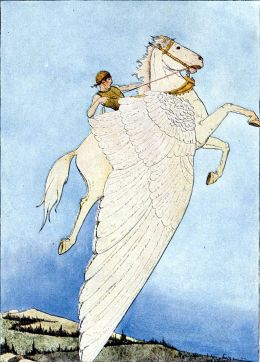
|
Horses and Religion – The
Equine Connection
by
CuChullaine
O’Reilly FRGS
|
Iconic
scientist Stephen Hawking was a Professor of Mathematics at the University of
Cambridge. He said, “We live in a universe governed by rational laws that we can
discover and understand.”
One such
attempt to discover evidence is connected to the question of when humanity
domesticated the horse and began riding. Genetic research published in a new
study indicates that the
horse-human relationship may have begun in 3,500 BC at Botai, Kazakhstan.
While the
question of where and when horses were domesticated continues to intrigue us,
what has eluded public notice is how horses had an unexpected and widespread
influence on how humanity developed different religious practices and beliefs.
Ancient
ideas helped shape our modern world. The origins of some of these concepts are
obscured by accretions from legend and myth.
Scholars
agree that religious theories offer various explanations regarding mankind’s
origin. Even though these theories provide widely different interpretations of
human history, all provide sociological and philosophical cultural comfort.
Because of
the endless variety of the human mind, “truth” is seldom interpreted in the same
way by any two people. Thus religious interpretation varies according to the
influence of national, racial, or ethnic identities. Yet there is a common
thread which encourages respect for what is sacred and a reverence for a higher
spiritual force whose exact definition remains beyond human comprehension.
 |
A map of
major denominations and religions of the world. |
During
man’s attempt to explain the meaning of life and the origin of the universe, he
has often consulted, incorporated, enlisted, worshipped, sacrificed and eaten
the horse for religious reasons.
A study of
religious practices reveals that horses had an important part to play in the
formation and development of human spirituality. Horses have been worshipped
since the Bronze Age. They have been consulted as divine oracles. Sacred horses
were deified because of their personal association with Divinities. Spiritual
horses carried the human soul to Valhalla. Valuable horses were sacrificed to
placate various gods. A religious equine taboo enacted in the 8th century AD
still influences the dietary habits of modern Americans and Europeans today.
Certain
ancient polytheistic religions such as those of Greece, Rome and Scandinavia are
no longer in fashion. Yet though many previous equine worship patterns are no
longer enforced, these practices were not restricted to the past. Certain modern
religions continue to revere the horse as a sacred totem.
This LRGAF
study presents what is believed to be the first global study of equine religious
imagery, all of which reveal the magnitude of influence that horses have had on
human religious belief.
Africa
|
African religious practices are highly diverse. They generally include oral
rather than scriptural traditions which include belief in a supreme creator,
veneration of the dead and the need for humanity to live in harmony with
nature. Shango is the mounted god of thunder, lightning and fire who
is worshipped in Yorubaland in Nigeria. The third king of the Oyo Kingdom,
after his death Shango became a deity who is noted for his anger. Believed
to be the most powerful in the pantheon of gods, Shango casts
“thunderstones” at those mortals who offend him. He is worshiped on the
fifth day of the week, which is named Ojo Jakuta and certain ritual foods,
such as bitter cola and gbegiri soup, are consumed in his honour. Shango is
invoked during coronation ceremonies in Nigeria to the present day. |
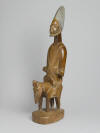 |
Assyria
|

|
Assyria was a Mesopotamian kingdom located in the Near East and the Levant
that existed as early as the 25th century BC.
Sennacherib,
the king of Assyria from 705 BC to 681 BC, is principally remembered for his
military campaigns against Babylon and Judah, which are described in the
Old Testament. A fierce warrior king, Sennacherib destroyed Babylon in
689 BC. He tells his story in simple yet eloquent words.
“I
hurled the weapon of Ashur, my lord, against them, inflicted their defeat,
cut off the heads of their warriors and dyed the mountain with the blood of
the defeated. I returned with chariots, cavalry and much property from the
palace, the weight of which is immeasurable.”
It was not only a political conquest but a religious war as well.
Sennacherib destroyed the temples and the images of the gods, except for
that of Marduk, the creator-god and divine patron of Babylon, which he took
to Assyria as a symbol of religious captivity. |
Buddhism
Buddhism originated in India between the 6th and 4th centuries BC. It spread
through much of Asia during the Middle Ages, eventually becoming the world’s
fourth largest religion, with more than 520 million followers. The religion
is practised in Tibet, which is the home of the Lungta, literally the
“wind horse.” A prayer flag depicting this mythical creature combines the
speed of the wind and the strength of the horse to carry the applicant’s
prayers from earth to heaven.
|
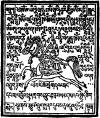 |
|
Siddhartha
is the birth name of an earthly prince who renounced the pleasures of the
world, became an ascetic and founded Buddhism. Believed to have been born in
Nepal during the 4th century BC, legend states Prince Siddhartha enjoyed
power and privilege. Kanthaka, a splendid white stallion purported to
have been born on the same day as Siddhartha, was given to the prince by his
kingly father. Mounted on the kingdom’s most valuable horse, Siddhartha
proved his capabilities as a warrior and thereafter won the hand of Princess
Yasodhara. At the age of 29 the prince journeyed through his father’s
kingdom, whereupon he saw sickness, cruelty and ageing for the first time.
Siddhartha thereafter decided to leave behind his life of luxury and to seek
enlightenment. Mounting Kanthaka, according to legend "the horse's hooves
were muffled by the gods" to prevent the palace guards from knowing of his
departure. Though their journey together is supposed to have occurred 2,500
years ago, legend states that when Siddhartha dismounted for the last time,
so as to continue his spiritual journey on foot, Kanthaka died of a broken
heart caused by the separation from the one he loved. Yet in an act of
divine grace, the faithful horse was reincarnated as an enlightened human
being. This image depicts Kanthaka leaping the river Anoma in the moonlight. |

|
Celtic
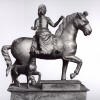 |
Epona
was a Celtic divinity who protected horses, ponies, donkeys and mules. She
and her horse also carried the departed human soul in its after-life ride.
Her name is derived from the Celtic word “ekwos” for horse. After the Celts
in Gaul were conquered by the Romans, worship of Epona spread among Rome’s
Imperial Horse Guard. Statues of the female horse tamer, which often depict
her riding, were worshipped as late as the third century AD. |
China
Astrology is an ancient type of divination. According to this belief stars,
planets and the moon influence the lives of humans on earth, according to
the position of these celestial bodies at the time of a person’s birth. The
horse is the seventh of the twelve animal signs associated with the
Chinese Zodiac. The Years of the Horse include
1918, 1930, 1942, 1954, 1966, 1978, 1990, 2002, 2014 and 2026. Belief in the
divinity of the horse led to a reverence of the animal as a village deity in
certain parts of China. The horse is believed to represent the element of
Fire (Huo), which symbolizes energy and enthusiasm. Persons born in the year
of the horse are believed to possess certain character traits, such as
strength and an outgoing nature.
|
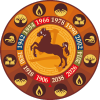 |
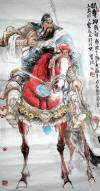 |
Appealing to Gods of Wealth is an important part of many Asian religious
beliefs. People in China who practise feng shui often seek the
spiritual assistance of Kuan Yu, the warrior god of wealth. Because
of his strong combative powers, Kuan Yu is often turned to by businessmen
seeking to overcome competition or to protect the wealth they have already
accumulated. |
Christianity – Old Testament
|
Horses
are mentioned in the Bible 175 times. Thirty-three verses
with the word horse appear in the Old Testament including the books of
Genesis, Exodus, 1 Kings, 2 Chronicles, Nehemiah, Esther, Job, Psalms,
Proverbs, Isaiah, Jeremiah, Amos and Zechariah. According to the Book of
Genesis, God created all living creatures on the Sixth Day of
Creation. This painting depicts God blessing the horse he has just created. |
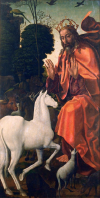 |
|
The Garden of Eden was the divine paradise where Adam and Eve resided
peacefully alongside the animals. One tradition states that when God
commanded Adam to name all the newly created creatures, the first one given
a name was the Unicorn. To signify its importance, God touched the
unicorn on the tip of its horn and anointed it with a special blessing.
After Adam and Eve disobeyed God’s command, they were banished from the
Garden of Eden. Unlike the other animals that were required to leave the
Garden, the unicorn was given the choice of remaining in the earthly
paradise or following Adam and Eve into the world of pain and death. Because
the unicorn chose to accompany the humans out of a sense of love, the
unicorn was forever blessed for his compassion. This tapestry depicts the
unicorn, alongside Adam and Eve, prior to their departure from the Garden of
Eden. |
 |
Christianity – New Testament
|
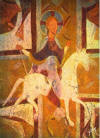 |
According to tradition Jesus led his Apostles on a journey across Palestine.
Those who journeyed with Jesus were a tired company, weary, hungry, thirsty,
foot sore and covered with the dust of the road. Traditionally Jesus the
Peaceful Pilgrim is shown mounted on a donkey because of his humble
status in the world. But one artist dared to be different. He alone painted
Jesus as a wandering horseman. In the Cathedral of St. Etienne, in the city
of Auxerre, in Burgundy, France, is a wall painting which depicts Jesus
riding a white horse, which usually stands for majesty. His right hand holds
a staff. His left hand is kept in a high position in a waving gesture or to
hold the invisible reins. There are no stirrups, which conforms to the
situation of that time. |
|
In
stark contrast to the image of a suffering saviour is another equestrian
interpretation which depicts Jesus the Returning Messiah. The book of
Revelation explains how Jesus will ride a white horse when he returns to
the Earth to usher in the Apocalypse. |
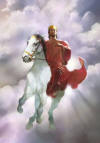 |
 |
The Four Horsemen of the Apocalypse,
described in the Book of Revelation, are harbingers of the Last Judgment.
The four angelic beings ride white, red, black, and pale horses that
represent the different tribulations that will affect the
"the four corners of the earth." The four angelic
horsemen are featured in the “Bamberger Apokalypse” Folio 14 recto (ca. 1000
AD). |
Christianity – Eastern Orthodox
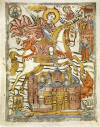 |
The Eastern Orthodox Church originated during the Roman Empire and continued
through the Byzantine Empire. With more than 250 million members, today it
is the second-largest Christian community and has played a prominent role in
the history of Russia, Eastern Europe, Greece and the Caucasus. Icons are
considered to be the Gospel in paint. The veneration of Saint George
is widespread. He is often depicted in icons as being the rescuer of a small
boy who was captured by Muslims. This type of icon also depicts George as a
dragon slayer. The concept of an equestrian hero slaying a dangerous reptile
dates back to at least 300 BC, when the mounted Egyptian god Horus slew the
malevolent Seth.
|
 |
The Gospels
of Tsar Ivan Alexander were created for the ruler of the Bulgarian Empire.
Written and illustrated in 1355, the Holy Scripture contains the Four
Gospels, written in Slavonic. There are 366 highly detailed miniature
images, including one that depicts the Nativity scene with the Three Wise
Men, the Magi, departing on horseback. Considered the most important
medieval cultural treasure produced in Bulgaria prior to the country’s
conquest by the Ottoman Empire, the treasured book is now listed as a world
heritage document. |
Christianity – Saints
Saint Eligius,
who lived in France in 588, is the patron saint of people who ride and work
with horses. This tapestry depicts Eligius performing a miracle. Having
encountered a horse possessed by a demon, Eligius wisely decided not to
struggle with the animal. In order to place a shoe on the animal’s hoof,
Eligius removed the horse’s leg from its body, nailed on the shoe, and then
miraculously reattached the leg onto the horse.
|
 |
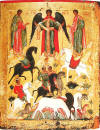
|
Saints Florus
and Laurus were brothers who converted to Christianity in the 2nd
century AD. Originally from Byzantium, they resettled in what is today
Albania. Inspired by religious zeal, they urged the residents of a town to
destroy statues of Roman pagan gods housed in the local temple and place a
cross atop the building instead. As a result of this vandalism, the
authorities ordered 300 Christians to be slain. The brothers were thrown
into an empty well, which was then filled with earth. According to Eastern
Orthodox tradition, many centuries later, during a severe equine epidemic,
the bodies of the slain brothers were found on the anniversary of their death.
Miraculously the epidemic immediately stopped and the brothers thereafter
became the patron saints of horses. The reverence for these equine saints
was so strong that Russian peasants would not work on that day, for fear of
causing a plague. They would instead lead their horses around the village
church in memory of the slain brothers. This annual ceremony was still being
practised in the 19th century and was recounted in “War and Peace,” written
by Count Leo Tolstoy. A renowned horse lover, in Tolstoy’s story
Strider,
the equine narrator recounts man’s cruelty to horses. “I was unfortunate
because people considered that I did not belong to God and to myself, as is
natural to all living creatures, but that I belonged to the groom.” This
15th-century Novgorod icon depicts the saints riding and surrounded by
horses.
|
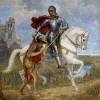 |
Saint Martin
is the patron saint of horses, equestrians and
cavalry. His father was a senior officer in the Roman army’s Imperial
Horse Guard. As the son of a veteran officer, Martin at fifteen was required
to join the cavalry. Though his parents were pagan their son converted to
Christianity. While riding through a forest in Gaul (now France), Martin
encountered a beggar. Noticing that the elderly man did not have enough
clothing to keep warm, Martin used his sword to cut the heavy cloak he was
wearing in half to share with the beggar. The cavalryman later had a
miraculous vision of Jesus Christ wearing the cloak. |
Confucius

|
The
Chinese philosopher Confucius (551 – 479 BC) taught a rationalistic
religion based on the Hundred Schools of Thought. One day while Confucius
was resting, his horse ran away and ate a farmer’s crop in the field. The
angry farmer caught the trespassing horse and refused to return it.
Confucius said, "It is my fault not the farmer's.” He then dispatched his
groom to attempt to reason with the farmer. The groom said to the farmer:
"You farm in the east and I live in the west. We don't know each other but
our crop looks the same. How can the horse know the crop is yours or mine?"
The farmer was fully convinced and happily returned the philosopher’s horse.
Confucius warned, ““Even
four harnessed horses cannot bring imprudent words back into the mouth.”
This image, known as “Night-Shining White,” was created by Han Gan in the
Tang dynasty, circa 700 AD. |
Egypt
|
The prehistoric concept of a mounted warrior slaying a reptilian monster
dates back to the origins of religion. One of the earliest depictions of
this myth involves the Egyptian god Horus battling the evil demon
Seth, who is depicted in crocodile form. Isis, mother of Horus, urged her
son to protect the Egyptian people from Seth, a deity associated with the
desert. The falcon-headed Horus was worshipped until Rome conquered the
Egyptian Empire, many centuries later. This carving is believed to date from
300 BC. |
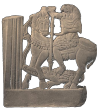 |
Ethiopia
 |
Christianity in Ethiopia dates to the ancient Kingdom of Aksum, when King
Ezana declared it as the state religion in 330 AD. In the early days of
Christianity, when converts were being persecuted by the Roman government,
religious refugees sought sanctuary in Ethiopia. The largest pre-colonial
Christian church of Africa, the Ethiopian Church has a membership of between
40 and 46 million, the majority of whom live in Ethiopia, and is thus the
largest of all Oriental Orthodox churches. The church Canon contains 81
books and the service is celebrated in the Ge'ez language. The Ethiopian
church claims that one of its churches, Our Lady Mary of Zion, is host to
the original Ark of the Covenant that Moses carried with the Israelites
during the Exodus. Horses have played a significant role in Ethiopia,
formerly known as Abyssinia. There are about 2.8 million horses in Ethiopia,
more than half the total in the African continent. This image depicts Saint
George, a reoccurring equestrian motif that has been depicted for centuries
in Abyssinia/Ethiopia. |
Gilgamesh
 |
The Epic of Gilgamesh is an epic poem from ancient Mesopotamia. The
first surviving version of the poem dates to the 18th century BC and
recounts the deeds of Gilgamesh, the king of Uruk. The oldest description of
a unicorn occurs in the Epic of Gilgamesh, and in Mesopotamian art it
is depicted as a great beast with a ringed neck and long, curving horn. In
the second half of the epic Gilgamesh undertakes a long and perilous journey
to discover the secret of eternal life. He eventually learns that "Life,
which you look for, you will never find. For when the gods created man, they
let death be his share, and life withheld in their own hands" |
Greek

|
The
Centaur is a mythological creature with the upper body of a human and
the lower body of a horse. Bronze Age (3300 -1200 BC) legend states that the
creatures inhabited the region of Mount Pelion in Greece. Yet the concept of
a horse-human was also revered in Indian religious belief and centaurs were
shown in stones carved by the Picts of Scotland as late as the 9th century
AD.
According to Greek mythology, the centaurs were feared because of their
physical violence, raging lust and love of drinking. They often waged war
against their human neighbours, the Lapith tribe and in one notorious
incident attempted to abduct a bride on her wedding day. This conflict
became a metaphor between the struggle between barbarism and civilisation,
with the centaurs representing mankind’s base nature. The great exception
was Chiron, who was revered for his wisdom. In addition to being a
respected astrologer and oracle, this centaur was a great healer who is
credited with the discovery of studying herbs as medicine. Chiron was also a
highly revered teacher, whose pupils included Achilles, Hercules, Jason and
Perseus. Upon his death, Chiron became known as the constellation Centaurus,
where he continues to inspire those on Earth. This painting, done in 1888 by
the Swiss artist Arnold Bocklin, depicts a centaur visiting the village
blacksmith’s shop.
|
The accursed
Mares of Diomedes
recounts the first gruesome tale of anthropophagic (man-eating) horses.
According to ancient Greek legend, King Diomedes of Thrace owned four mares
named Podargos, Lampon, Xanthos and Deinos. These savage equines were fed on
the human flesh of any hapless stranger unlucky enough to visit the despot’s
kingdom on the shores of the Black Sea. The Grecian playwright, Euripedes,
and the historian, Apollodorus, both recounted how Hercules was given
the task of capturing these murderous horses and bringing them back to
Greece. Several Grecian champions were invited to accompany Hercules on the
voyage to Thrace. Upon their arrival, while Hercules fought the army of King
Diomedes, his companion, Abderos, was tasked with guarding the murderous
mares. While Hercules was occupied in battle, Abderos was killed and
consumed by the meat-loving mares. Ironically, in an act of ultimate
equestrian revenge, when Hercules overthrew the dictator, the legendary
strongman “cast the tyrant’s still quivering carcass to his own horses to be
devoured.” This painting by Gustave Moreau depicts King Diomedes being eaten
by his man-eating mares.
|

|
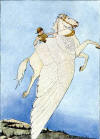
|
Pegasus
is a mythical winged divine stallion and one of the most recognized
creatures in global mythology. Usually depicted as pure white, according to
Grecian lore Pegasus was the child of the Olympian god Poseidon. A bronze
Greek figurine of the flying horse is estimated to have been created in 500
BC. According to legend Pegasus was peacefully drinking from a spring when
the hero Bellerophon captured him with the use of a golden bridle. Pegasus
allowed Bellerophon to ride him in order to defeat the monstrous Chimera.
Bellerophon later fell from the winged horse's back while trying to reach
Mount Olympus. Zeus later honoured Pegasus by transforming him into a
constellation in the northern sky. It was one of the 48 constellations
listed by the 2nd century astronomer Ptolemy. A symbol of wisdom and speed,
the concept of a winged horse was not restricted to Greece. The Parthians of
ancient Persia worshipped a winged horse called “Pegaz.” Chinese and Hindu
astronomers contain references to the flying equine. According to Islamic
tradition, Haizum is a winged white horse that transports the archangel
Gabriel from one cosmic plane to another in a second. A winged horse known
as the Tulpar is the state emblems of Kazakhstan and Mongolia. More
recently, the concept of a flying stallion was updated with the publication
of
Count Pompeii,
the flying Cossack stallion that is the logo of the Long Riders’ Guild. |
Hindu
Horse worship in India is believed to date back to 2000 BC, when Indo-Aryan
people began to migrate into the Indus valley. The horse, which represented
speed, strength and intelligence to the Aryans, was later deified when
followers of Hinduism began worshipping Hayagriva, a horse-headed
avatar. Revered as the god of wisdom, Hayagriva represents the triumph of
knowledge, guided by the hand of God, over the demonic powers of passion and
darkness. In his right hand Hayagriva holds a rosary which is indicative of
the wisdom gained through meditation. His left hand holds a book, revealing
his role as a teacher. Always serene, his blessings are sought when
beginning the study of both sacred and secular subjects.
|
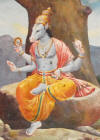 |
According to Hindu cosmology, a kalpa is a Sanskrit word meaning the period
of time between the creation and recreation of the universe. The ancient
Hindu scripture known as the Purana states that there are four
cycles, each lasting millions of years. The cycle of Satya, which lasted
nearly two million years, was characterized by the absence of ignorance.
Vice entered the world during the Treta cycle, which lasted 1,296,000 years.
A greater decline in virtue lasting 864,000 years happened during the
Dvāpara cycle. Finally, the Kali cycle, which has been underway for the last
5,000 years, will witness an abundance of strife and ignorance.
In a remarkable similarity to the Christian Bible’s Book
of Revelations, which refers to a returning spiritual lord slaying wicked
non-believers and establishing a heavenly reign, the Vedic culture reveals
that Lord Kalki will appear on a white horse named Devadatta. Armed
with a drawn sword, the mission of Lord Kalki will be to slay
unbelievers, end the age of hypocrisy and re-establish religious principles
which will allow goodness to reign supreme.
|
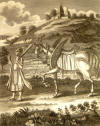
|

|
Krishna
is the god of compassion, tenderness, and love in Hinduism. Arjuna
was a famous warrior and is a central character in the Hindu scripture, the
Bhagavad-Gita. The friendship between Krishna and Arjuna is the most
celebrated bond in Hindu mythology. The Bhagavad-Gita, which relates the
conversation held between Krishna and Arjuna before the Battle of
Kurukshetra, is considered a philosophical classic. On a superficial level
the painting done by Geeta Upadesam depicts Arjuna as a passenger in a
chariot driven by Lord Krishna. Yet the painting invokes many Hindu beliefs.
The chariot represents the human body. The passenger, Arjuna, represents the
embodiment of the individual soul. Krishna represents the Higher Self
leading the chariot into a battle waged between the demonic and divine
nature that is undertaken in the inner battle of each individual’s mind. The
reins represent the operation of the mind. The horses represent the senses.
Hindus believe that Krishna helps humans in their struggle to obtain Dharma
(righteousness).
|
|
Kerala, in southern India, is the site of an important equine religious
ceremony known as Machad Mamangam. Believed to be one of the oldest
festivals in Kerala, according to legend it began when the local king wished
to honour the goddess Kavil Amma by bringing valuable horses to the
Thiruvanikkavu temple as an offering. Yet because there were no horses in
his kingdom at that time, the monarch and his subjects created enormous,
highly decorated artificial horses instead. These giant horse figurines are
made from bamboo, filled with straw, and covered in colourful silk cloth.
This unique five-day festival is held every three years. The culmination of
the celebration occurs when men from nearby villages carry the five giant
horses through the countryside to the temple. They are accompanied by
musicians and thousands of joyful devotees who believe that the delivery of
the horses to the goddess will ensure prosperity and harmony.
Photo courtesy of Santhosh Kumar Machad. |

|
Islam
 |
Horses
are mentioned in
the
Qu’ran six times. The Muslim holy book
explains that Allah created horses, known as “El-Kheir”, the supreme
blessing, for humanity’s benefit and pleasure.
“Allah created the horse from the wind as he created Adam from clay. He said
to the south wind, ‘I want to make a creature out of you. Condense,’ and the
wind condensed. Allah said to the horse, ‘I will make you peerless and
preferred above all the other animals and tenderness will always be in your
master’s heart. You alone shall fly without wings. All the blessings of the
world shall be placed between your eyes and happiness shall hang from your
forelock.’”
|
|
An
Ayat is a portion of the Qu’ran. Islamic calligraphers were renowned
for their ability to transmit an ayat in various artistic forms. Ayat al-Kursi,
(The Throne Verse), Surah 2:255, was transformed into an equine form by a
Mughal calligrapher in the 16th century.
“In the name of Allah, the Beneficent, the Merciful.
Allah! There is no God but He,
the Living, the Self-subsisting, the Eternal.
No slumber can seize Him, nor sleep.
All things in heaven and earth are His.
Who could intercede in His presence without His permission?
He knows what appears in front of and behind His creatures.
Nor can they encompass any knowledge of Him except what He wills.
His throne extends over the heavens and the earth,
and He feels no fatigue in guarding and preserving them,
for He is the Highest and Most Exalted.
Allah, the Most High, speaks the truth.”
|
 |
|
According to Sunni Islam, a hadith denotes the words, actions, and
the silent approval, of the Islamic prophet Muhammad. According to one
hadith, the Prophet Muhammad was resting at the Kaaba when the angel Jibril
(Gabriel) appeared. The angel brought the Burāq,
a mythical steed, that transported the Islamic Prophet from Mecca to
Jerusalem and back. The Burāq is often depicted as a mare with the features
of a beautiful human female. This illustration shows the Burāq flying over
the Dome of the Rock in Jerusalem, one of Islam's holiest mosques, while
behind her is the Tomb of the Prophet, located in faraway Arabia.
|
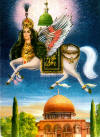 |
In times past, the Islamic world accommodated traditional and pre-Islamic
practices at the highest level. For example, in 1402 the Turkic conqueror
Tamerlane consulted astrologers prior to engaging in battle with Sultan
Bayazid, the ruler of the mighty Ottoman Empire. Muslim scholars, such as
Ahmad ibn Ali al-Buni, investigated the occult properties of the 99 names of
Allah in the 12th century and advised the faithful how they could harness
supernatural power through amulets and talismans. This Shia talisman
from Persia displays a magic square and patterns that enable a wife to
control her husband.
|
 |
|
Sufism exists in both Sunni and Shia Islam. Instead of focusing on external
ritual practices, Sufis strive to obtain direct contact with Allah by
purifying their souls with the help of mystical practices. To achieve
harmony with Allah, the Sufi undertakes training that enhances their
intuitive and emotional faculties. The purpose of this training is the
development of the human soul by overcoming seven different levels of
temptation and corruption. One of the hardest battles is man’s battle with
his individual ego. Evil attributes such as anger, lust and ego must be
individually overcome. This image depicts the Sufi in battle against the
dark powers of Ego. |
 |
Jains
|
Devotees of Jainism are known as Jains, a Sanskrit word meaning
victory in managing to cross over various rebirths and finally achieve
spiritual freedom from the cycle of karma. The Jain sacred text known as the
Tattvarthasūtra teaches the principles of non-violence and
non-attachment to worldly possessions, which are fundamental tenets of
Jainism. Though Hinduism and Buddhism canonical texts also stress
non-violence, no other Indian religion has developed the non-violence
doctrine and its implications on everyday life as has Jainism. Jains believe
a succession of twenty-four victorious saviours have guided humanity through
its various cycles of existence. These enlightened human beings triumphed
over karma and reached a state of omniscience. Sambhavanath, the
third tirthankar (omniscient teaching god), is symbolized by the horse.
One Jain prayer states, “I forgive all living beings, may all living beings
forgive me. All in this world are my friends, I have no enemies.” |
 |
Judaism

|
Judaism,
the religion of the Jewish people, is an ancient monotheistic religion
that refers to the Torah as its foundational text. The Torah consists
of many books which describe the origin of the Jews and explains the special
covenant which “the Children of Israel” have with God. The book of Exodus
explains how Moses led the Jews from captivity in Egypt towards a promised
land. After their departure from his kingdom, the Egyptian Pharaoh
changed his mind and set off in pursuit in the company of an army of
chariots. According to Exodus, Moses held his staff aloft, whereupon
God parted the Red Sea. Moses and his followers escaped across the
exposed ground. But when the Egyptians attempted to follow, the sea came
crashing down and drowned the pursuers. This dramatic
event is known and revered in other religions too. For example, the
story is mentioned in the Qu’ran in Surah 26 and this wall painting was
created in an Orthodox Russian church in 1640. |
Korea
 |
Koreans on both sides of the DMZ (demilitarized zone) revere the Chollima,
which is an Asian version of the Pegasus myth. But the winged horse is
literally worshiped in North Korea. Supposedly able to gallop one thousand
li (approximately 400 km) in a single day, the Chollima is a symbol of
people who achieve feats requiring exceptional strength and endurance. For
this reason it gave its name to the Chollima Movement, which promoted fast
economic development, similar to that of the Chinese Great Leap Forward. The
photo shows tens of thousands of people engaged in a torch light parade
beneath the 120 foot high Chollima statue in Pyongyang, North Korea. |
Mormon
|
The Book of Mormon is a text of scripture for members of The
Church of Jesus Christ of Latter-day Saints. The religious movement began in
New York in the 1820s after Joseph Smith received a series of visions
wherein God instructed him to re-establish a true Christian church. The Holy
Scripture, which was preserved on a series of golden plates, was written in
an Egyptian language but was translated with the help of two angels who
assisted Smith. The faith stresses that the purpose of earthly life is to
learn to choose good over evil and that life on earth is just a short part
of an eternal existence. The book also recounts how a diaspora of Israelites
left Jerusalem in 600 BC and migrated to North America. Led by descendants
of the prophet Lehi, these people, known as the Nephites, interacted with
other residents of the ancient Americas, including the Lamanites and
Mulekites. There are several references to the presence of horses in the
text, including one verse which describes “their land is also full of
horses, neither is there any end of their chariots.” This painting, by an
unknown artist, depicts the final battle of the Nephites. |

|
Native American
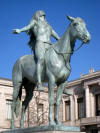
|
Native Americans have diverse origin myths. For example the Mohawks believe
in Raweno, a creator god who is a benevolent caretaker, while the Blackfoot
tribe revere Kipitaki, an Old Lady who taught humanity new things. Thus
interpretations of the incarnation of the Great Spirit differed. But the
idea that a universal spiritual force took a personal interest in worldly
affairs and was dedicated to the preservation of the Native American way of
life is widely believed. This conviction in the power of divine retribution
was the focus of a religious resistance which resulted in tragic events. The
Ghost Dance was a spiritual movement that began after Wovoka, a
Paiute born in Nevada, experienced a dream during a solar eclipse that
occurred on January 1, 1889. According to this prophet, he journeyed into
the spirit world. There he saw Native Americans being lifted into the safety
of the sky, while the Earth opened and devoured all foreign invaders. Upon
returning to the restored planet, Native Americans would find the natural
environment restored. Luxurious grass, fresh water and abundant trees would
shelter and feed great herds of buffalo and wild horses. In order to bring
about this remarkable terrestrial transformation, Wovoka urged Native
Americans to participate in a special five-day dance which induced a state
of religious ecstasy. In 1890 more than 150 men, women and children of the
Lakota tribe, many of whom had been participants in the Ghost Dance
movement, were killed in the Wounded Knee Massacre. In 1909 Cyrus Dallin,
who had been born in Utah Territory and whose interaction with Native
American children had influenced his childhood, created an equestrian statue
known as the Appeal to the Great Spirit. |
Norse
In Norse mythology, Odin is the god associated with wisdom, healing
and death. He frequently travelled through the world of men on
Sleipnir,
a legendary eight-legged horse. Like the miraculous Burāq of
Islam, Odin’s steed could travel instantly across land or through the sky.
There is a disagreement about why the horse had eight legs, with some
believing the legs to be symbolic of the eight spokes of the solar wheel,
while others think they represent points on the compass. The one-eyed rider
and his magical steed appear in various literary accounts, including the
Völsunga saga, a 13th century Icelandic epic poem.
|
 |
A
Nidstang
is an ancient
Scandinavian
custom of formally cursing or hexing someone. This practice
requires placing a horse’s head, or in some instances the entire equine
carcass, on a wooden pole, which is pointed in the direction of the person
on which the curse is meant to be inflicted. Runes invoking the curse were
often carved on the pole as well. The practice was recorded in Egil’s
Saga, an epic account which begins in Norway in 850 AD. Having been
offended by King Eirik and Queen Gunnhild, Egil erected a “scorn pole” which
appealed to the nature spirits to drive the ruling couple from their
thrones, a hoped-for outcome which did indeed come to pass. This cultural
tradition continues to be practised today, with one example occurring in
Norway in 2006 when an aggrieved politician raised Nidstang poles in protest
over a local election.
|
 |
People residing in Europe, such as the Balts, Celts, Norse, Slavs and
Teutons worshipped a pantheon of gods, including Thor, the god of
thunder. The blóta was a special yearly sacrifice where a horse was
killed by a priest known as a gothi. Because the blood was deemed to
possess special powers, it was sprinkled on a statue of the god. The meat
was then boiled in large cauldrons and the subsequent meal was a time
wherein the people said a prayer for “a good year and peace.”
Since eating horse flesh was connected to pagan worship, this practice
became a point of bitter religious conflict in 732 AD, when Pope Gregory III
sent Bishop Boniface a letter which stated, “You say that some eat horses.
By no means allow this to happen in future but suppress it in every possible
way with the help of Christ and impose a suitable penance upon offenders. It
is a filthy and abominable custom.”
This
Catholic decree
was enforced in most European regions. Centuries later this culinary taboo
travelled across the Atlantic, along with horses themselves, to North
America. This taboo remains woven into the social fabric of English-speaking
countries and explains why California law makes it a felony to offer
horsemeat for sale for human consumption. This painting by J. L. Lund
depicts a gothi (priest) leading the people in sacrificing a horse to an
idol of Thor. |

|
Philippines
|
The Tikbalang is a legendary creature said to inhabit
sparsely-populated parts of the Philippines. A tall creature with the head
and hooves of a horse, it was said to hide in dark foliage, beneath bridges
and in bamboo clumps. Believed to date back 4000 years, stories about the
Tikbalang detail how the creature would lead travellers astray. Equipped
with a mane of sharp spines, this demon horse could only be overcome if a
brave person jumped on its back, and using a specially prepared cord as a
bridle, was able to hold on while the creature fought madly to dislodge the
unwelcome rider. |
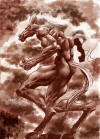 |
Roman
 |
Originally worshipped by the Greeks as the patron of the Oracle at Delphi,
Apollo was worshipped as the god of healing, the sun and poetry.
Cyrene, the daughter of King Hypseus, was a skilled huntress who protected
her father’s cattle. When a lion attacked the herd, she did not kill the
predator with her javelin, but wrestled with it until it succumbed.
Having observed Chiron’s strength and beauty, Apollo abducted her and flew
her to Libya in his heavenly chariot. There she gave birth to a son named Aristaeus, who was later mentored by Chiron the centaur. The painting
“Apollo Abducting Cyrene” was done by Frederick Arthur Bridgman.
|
 |
Castor and Pollux
were semi-divine twins known as the youths of Zeus. Renowned for their
bravery, they took part in the Argonaut expedition. Pollux was a skilled
boxer but Castor was a brilliant horse tamer. Both are frequently depicted
riding or standing next to their horses. In 496 BC the Romans won a major
battle, which they attributed to the heavenly help of the twins. A temple
was constructed in Rome in their honour and they were thereafter the patrons
of Roman knights. The constellation Gemini is Latin for “twins” and is named
in their memory. This pair of Roman statues depicts the celebrated horsemen.
Photo courtesy of Marie-Lan Nguyen.
|
|
Neptune
was the god of the sea who was worshipped by the Romans. He was also the god
of horses and horse racing. According to legend, his chariot was pulled by a
team of watery horses. In order to appease Neptune, sailors would sometimes
sacrifice a horse to him prior to departing on a journey. His temple in Rome
was located near the Circus Flaminius, the Roman racetrack. |
 |
Scientology
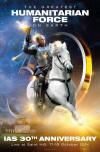 |
The Church of Scientology was created by an American author, L.
Ron Hubbard, in 1952. According to this religious conviction, humans are
immortal spiritual beings residing in a physical body. Each individual goes
through numerous incarnations and has experienced past lives. Hubbard taught
that “man is basically good and that his survival depends on his attainment
of brotherhood with the universe.” This desire to achieve spiritual
enlightenment proves that “its origins are as ancient as religious thought
itself.” Hubbard’s first book, Dianetics, was published in 1950.
However in 1938 he composed a manuscript entitled Excalibur which influenced
the more famous publication. In 2014 Scientologists in Great Britain
celebrated a 30 year religious event by invoking the equestrian legend of
King Arthur. |
Scythian
|
The Scythians were a nomadic equestrian tribe that inhabited the
Eurasian steppes beginning in the 9th century BC. These Bronze Age people
were among the earliest people to become accomplished mounted warriors. They
also believed in gods and goddesses, including Gaia, the female
personification of the Earth, who would meet them in the after life. One
notable religious practice was horse burial. When a rich tribal chief died,
he would be placed inside a wooden log building. Alongside his body would be
placed opulent treasures. Prized horses would be killed and laid along the
outside of the building. The entire affair was then covered with earth and a
large mound, known as a kurgan, would mark the spot of the chief’s departure
to Otherworld. In 1897 a Russian archaeologist excavated the kurgan of a
Scythian chief who had died in the 7th century BC. The sketch drawn by N.I.
Veselovski depicts how twenty-two horses had been carefully placed around
the departed chief’s body. |
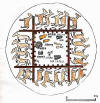
|
Serbia
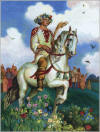 |
Jarylo
is the Slavic god of fertility. He spends part of each year dwelling in the
underworld, which was assumed to lie across the sea where migrating birds
would fly to during winter. Ancient mythical texts recount how “Where Jarylo
walks, there your field gives birth.” In Serbia May 6 is known as Đurđevdan,
a feast day which celebrates Jarylo’s return, many customs connected with
fertility are practised. Early that morning women ceremonially drown wreaths
of flowers in flowing water, so as to ensure ample rain for the year’s
crops. With the advent of warm weather, the people are free on that day to
indulge in a feast of fresh bread, milk and meat. That night people dance
and leap over bonfires to celebrate the return of the earth’s life force. |
Shinto

|
Shinto,
(the way of the gods) is the traditional religion of Japan. It involves the
worship of numerous spirits known as kami. These spirits manifest themselves
in various forms including rocks, trees, places and animals. The white
stallion is a sacred creature in Shinto. At the shrine located at Ise this
sanctified horse is venerated and paraded before the Sacred Spirits
thrice monthly, to celebrate the ties between the Sun Goddess and the head
of the Empire.
The tremendous religious significance of Japan’s white stallion was
demonstrated during the Second World War. After the Japanese bombed Pearl
Harbor, the Americans vowed revenge. One of the strangest demonstrations of
that national obsession was the country's determination to capture the white
charger ridden by Emperor Hirohito. According to propaganda widely
circulated at the conclusion of the war, the legendary white horse was
paraded in triumph across the United States. Yet research done by the Long
Riders’ Guild Academic Foundation revealed that the Emperor's horse was
never captured and that an elaborate
equestrian deception
was perpetrated on the American public.
|
|
According to the
Nihongi Chronicles
(720 BC), when a member of the Imperial Family died, his holdings, retainers
and horses were interred alive with him. Emperor Suinin ended
this practice, reasoning that it was more humane to use clay figurines
representing the assets of the deceased than to bury the real ones. People
began to offer live horses to the shrines. This created two conflicts. What
could the priests do with so many live horses? And spiritual anguish was
experienced by those devotees who were too poor to offer an expensive
animal. Around the Eighth Century, instead of live animals, the faithful
began using small tablets with a picture of a horse (hence
絵馬
E-picture-ma
horse)
as a votive gift. By the Heian period (794-1185
AD) the horse was viewed by the nobility as more of an elegant accessory
than a weapon of war. Commoners relied on the horse as an agricultural
partner and a travelling companion.
Hatsuuma the First Horse-Day-Festival (often the second day of the
second month) is one of the best examples of an association of the Divine
Horse with the agricultural base of the nation. A 711 AD legend says
that, on the Day of the Horse, in Fushimi, Kyoto, the God of Agriculture,
business and prosperity, Inari, descended from the mountain.
Currently, all throughout Japan, the god’s devotees visit his shrines, to
pay their respects. They come accompanied by horses elaborately decorated;
or they offer prayers
on top of straw horses. |

|
Siberia
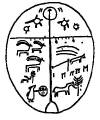 |
Shamanism
is a religious practice that involves the influence of benevolent or
malevolent spirits on humans. Shamans are men and women who have the ability
to enter into a trance and interact with the spirits of nature. Once widely
practiced among the Mongols, Turks, Finns and Hungarians, Siberia still has
a strong enduring connection to shamanism. In 1692 the Dutch traveller
Nicolaes Witsen was the first foreigner to document the appearance and
practices of a Siberian shaman. This illustration, which was recorded in the
Altai Mountains in 1909, is depicts the tree of life. Though its roots are
in the underworld, the tree rises through the world inhabited by humans and
animals to the stars above. Below the horizontal line on the left is the
shaman holding the sacred drum used to enter a trance and travel to the
spirit world. A horse stands to the right of the tree. Directly above, the
horse is seen after it has been sacrificed and its skin is hung on pole
known as a tayilga. This Siberian practice of religious horse sacrifice
matches the Scandinavian
custom. |
Sikh
|
Sikh,
(meaning a "disciple", or a "learner"), is a religion that originated in the
Punjab region of the Indian subcontinent about the end of the 15th century.
The religion is based on the spiritual teachings of Guru Nanak, the first
Guru (1469 – 1539) and the nine gurus that succeeded him. Guru Granth
Sahib, the Sikh’s Holy Scripture, emphasizes the equality of all
humankind, encourages people to strive for social justice for the benefit of
all mankind, and teaches followers to overcome the "Five Thieves" (lust,
rage, greed, attachment, and ego). Perhaps more than any other religion,
horses, riding and travel, are of historical and spiritual significance to
the practitioners of Sikhism. Horses are mentioned many times in the Guru
Granth Sahib and there are many tales of how the gurus who founded Sikhism
rode on horseback. For example, Sri Guru Ram Das Sahib Ji regularly rode
horses when travelling to far away places like Lahore and Amritsar. Sri Guru
Hargobind Sahib Ji created the first Sikh cavalry and fought a number of
defensive battles against the Mughals. And Sri Guru Gobind Singh Ji was the
rider of a renowned blue horse. Equestrian riding and travel were considered
so fundamentally important that one Sikh guru stated, “How can we understand
certain Sikh concepts or Sikh history if we have not experienced horse
riding for ourselves?” |
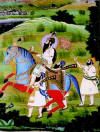
|
Slavic
,%20Croatia,%20VIII%20century._small.JPG)
|
The mightiest god in Slavic pagan mythology was Perun, the thunder
god who was associated with horses. Slavic, Norse and Baltic mythologies all
shared a belief in a sacred oak tree. Its roots reached into the underworld,
while its trunk and branches stretched up, past the living world of men and
animals, into the heavens. A demon named Veles dwelt deep in the underworld
under the roots of this tree. When he ventured into the world of men, to
steal their children and cattle, Perun would pursue Veles. The crafty demon
would attempt to hide, but Perun would attack him by throwing lightning
bolts from the sky. People believed that wherever lightning struck the
earth, it signified where Veles had been hiding. This enduring idea of a
battle between the forces of good and evil, represented by heaven and the
underworld, was later adapted into Christian ideology, which taught that God
cast Satan into Hell and protected humanity from evil.
|
|
Sventovit
is the god of war worshipped by Serbians, Croats, Bosnians, Czechs, Slovaks,
Poles and Slovenians. A special temple dedicated to this deity was built by
the inhabitants of Jaromarsburg, where a priest predicted the tribe’s future
by observing the actions of a white stallion. The horse, acting as an
oracle, would react to dice thrown by the priest, thus predicting future
events. Sacred horses were also housed in other Slavic pagan temples, were
they would forecast the future on the basis of how the horse walked through
rows of spears stuck in the ground. This painting, drawn by Józef
Ryszkiewicz in 1890, depicts a sacred stallion making a prophecy before the
tribe goes into battle. |
 |
Tao
|
The religious philosophy of Taoism urges humanity to respect the
“Three Treasures,” humility, compassion and frugality. Often times simply
referred to as “the way,” adherents attempt to live in harmony with nature,
other humans and animals. The Taoist master Lieh Tzu recounted a
story which reflected these principles. There once lived a rich noble who
wanted to purchase a new horse. He asked a courtier where the finest horse
might be found, to which the advisor replied that he had a friend whose
knowledge of horses was unsurpassed. The expert was requested to obtain and
send the best horse money could buy. Soon afterwards a letter arrived from
the expert, wherein he explained that he was sending a beautiful black
stallion as a gift to the prince. Yet when the anticipated horse arrived,
the new owner was shocked to see that a brown mare had arrived instead. The
angry nobleman complained to his courtier, “You swore your friend was an
expert but he can’t even distinguish a mare from a stallion or describe the
correct colour.” Wise in the ways of Tao, the courtier replied, “My friend’s
understanding of horses is so profound that he bases his decision on the
inner quality of the horse, not its outer characteristics.” |

|
Tarot
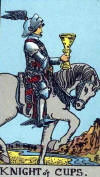 |
Tarotology
is the belief that certain cards can predict future events or gain knowledge
about the past, depending on which card is turned over. This divinatory
power is guided by spiritual forces that use the cards as instruments of
prediction or warning. Though some people believe tarot cards date back to
ancient Egypt, a French clergyman named
Antoine Court de Gébelin
is credited with promoting Tarot cards as an arcane repository of timeless
mysterious wisdom in 1781. Though the drawings on the 22 cards differ from
century to century and country to country, the most famous deck was
published in 1910. It was drawn by Pamela Colman Smith upon the instructions
of the mystic A.E. Waite. Known as the Rider-Waite deck, it contains the
card known as The Knight of Cups. The card depicts a knight riding a white
horse. This knight represents change and opportunity. If the card is dealt
upright it can represent romantic change. If dealt reversed, it indicates
fraud and trickery. |
Turkey
|
The world’s oldest known shrine, known as Göbekli Tepe, is believed to have
been erected in 11,500 BC. Predating the Great Pyramids of Giza by 7,000
years, the site in modern Turkey contains 20 16-ton limestone pillars.
Archaeologists believe that at least 500 people would have been required to
extract and move the immense pillars. The pillars were erected in a circular
pattern resembling Stonehenge. Two twin pillars stand at the centre of the
mysterious temple. Each of the pillars is carved with a variety of animals
and human figures. One pillar, known as the Goat and Horse Stone, appears to
have carvings which depict these two animals. Scientists are still debating
the purpose of Göbekli Tepe; with some saying it was a site where shamanic
religious ceremonies were held. Others have suggested that the carvings
represent constellations in the night sky. Photo courtesy of
Timothy Stephany.
|

|
Uffington Horse

|
Horse worship is known to date back to the Bronze Age (3300–1200 BC).
Widespread belief that the horse was a divine creature was shared by many
Eurasian nomad cultures. Cults of horse worship and sacrifice flourished,
which resulted in the creation of a gigantic earthwork known as the
Uffington Horse. Located on a hillside in Oxfordshire, England, it
measures almost four hundred feet long. It was created by digging the figure
into the earth and then filling the trenches with powdered chalk.
Archaeologists believe that the horse’s alignment with the sun, especially
in midwinter when the sun seems to overtake the horse, implies that it
represents a solar horse and is connected to the ancient belief that the sun
travels across the sky on a horse. Regardless of its original purpose, the
landmark has been faithfully protected and maintained throughout the ages.
In 1736 Francis Wise recounted how a centuries-old practice was still
enacted wherein people from all the neighbouring villages would undertake to
scour and renew the magical horse every seven years. |
Vedic
|
The Vedas are ancient Indian religious texts believed to date back to
1500 BC. Written in Sanskrit, there are repeated references to horses,
including a story of how the first horse, which was white in colour and had
wings, emerged from the sea. The Ashvamedha was a special ritual that
involved the sacrifice of a stallion. To prove their political power,
ancient Indian kings would release the stallion, which was then free to
wander across the land for a year. The horse was accompanied by a hundred
soldiers and princes, who were instructed to guard the animal during its
travels. Political rivals could dispute the king’s authority by challenging
the soldiers and stopping the horse. The conclusion of the horse’s journey
demonstrated the king’s political power. But to ensure the prosperity of the
kingdom and the fertility of the king’s lineage, the queen was required to
conclude the royal fertility ritual by participating in an act of sex magic.
The queen bathed and anointed the horse with ghee. A priest then killed the
horse, after which the queen was required to spend the night with the dead
animal in a simulated sexual act. This practice was later forbidden. Yet
similar rites involving the sacrifice and sexual involvement with a horse
were practised in other lands. In ancient Ireland, for example, a pagan rite
married a Celtic king to a sacrificed horse. Germans, Persians, Chinese and
Greeks also sacrificed horses for religious purposes. This painting depicts
Lord Krishna greeting the horse and its soldier attendants before the start
of the animal’s journey through the kingdom. |

|
Wicca
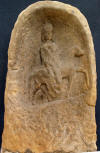 |
Rhiannon
was a politically-astute Welsh queen who was credited with magical powers
and is strongly associated with horses. An ancient collection of stories
known as the Mabinogi recount how Rhiannon rode a white horse that no
man could overtake. The paradox was that even though Rhiannon’s horse
appeared to be ambling, men mounted on galloping chargers could chase the
magical rider for days but never catch her. Modern day practitioners of
Wicca are adherents of a pre-Christian pagan religion. They believe that
Rhiannon represents the goddess of fertility. This movement, which was
strongly influenced by Gerald Gardner in the 1950s, is sometimes referred to
as the “Craft of the Wise.” There is no sacred text, though many adherents
respect a text known as the Book of Shadows. According to Wicca
tradition, the Law of Threefold Return states that whatever benevolent or
malevolent actions a person performs will return to that person with triple
force. |
Zoroaster

|
The name Zoroaster is a Greek rendering of the name Zarathustra. The
name refers to the prophet born in Bactria in the 6th century BC, who at the
age of thirty had a visionary experience in which he was led by a shining
being into the presence of Ahura Mazda, the lord of wisdom. The sacred
scripture of the religion is the Avesta. It proclaims there is one
creative and sustaining force in the universe and that this force grants
humans the right to choose between right and wrong, truth and falsehood.
Zoroastrian theology is described as the world’s first ecological religion,
because it admonishes its believers to protect nature. Fire and water are
both believed to be agents of ritual purification. Anahita is the
female divinity associated by Zoroastrians with water and wisdom. This
statue depicts her being drawn in her chariot by her horses named Cloud and
Rain. |
An
effort has been made to properly attribute the images used in this study. I
believe they are in the public domain or licensed as creative commons. However
if any image has been accidentally misattributed or used, please
contact the author and it
will be removed immediately.
©
CuChullaine O'Reilly 2018, All Rights Reserved
Home
Back to The Long Riders' Guild
|